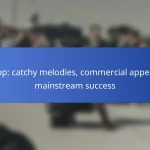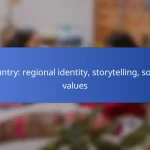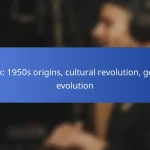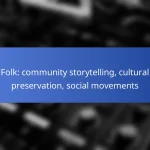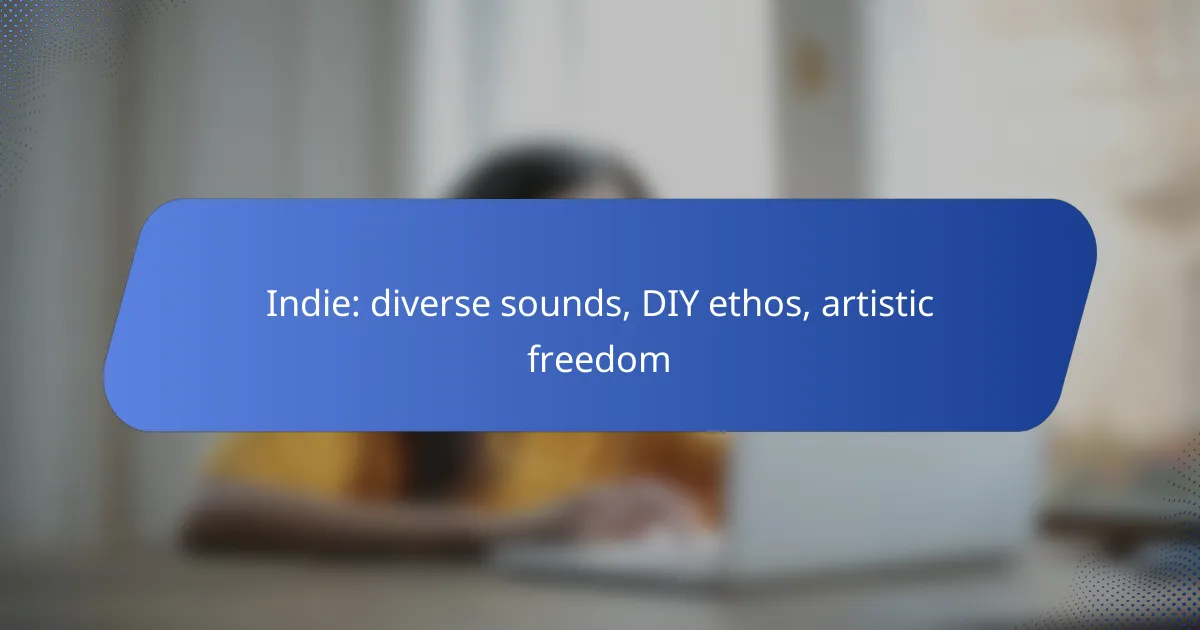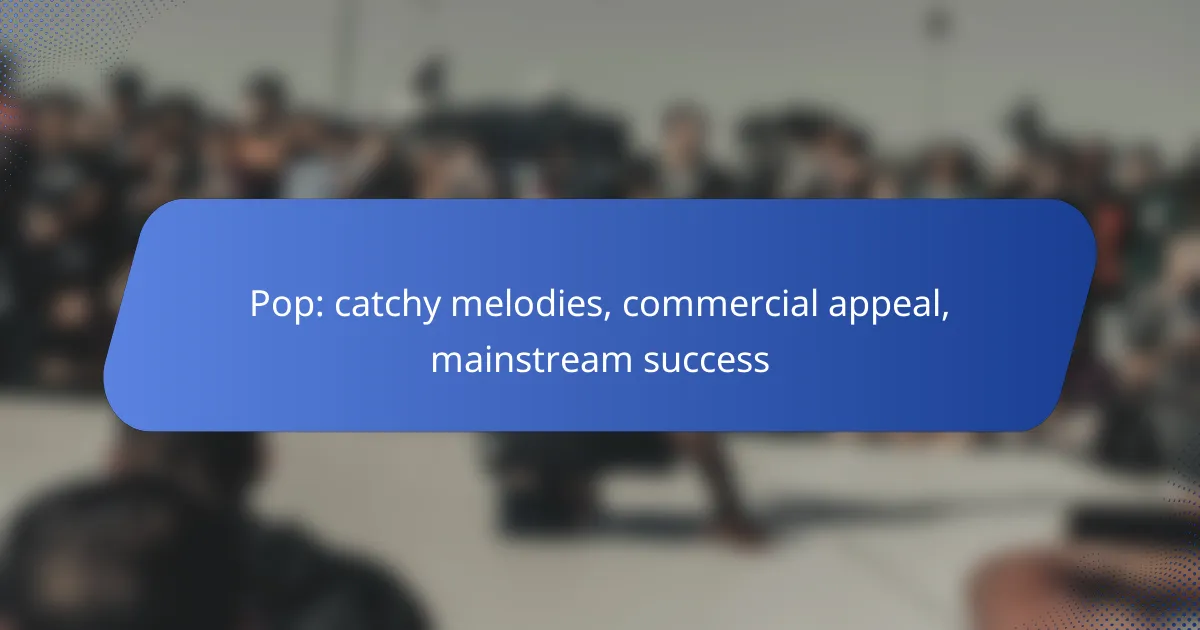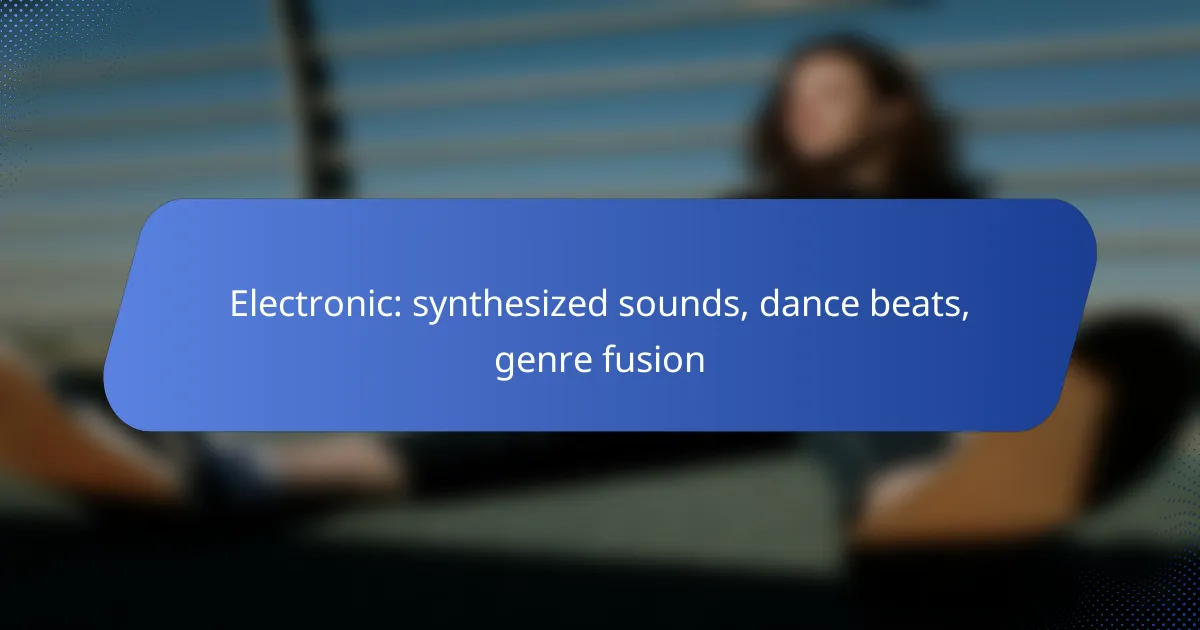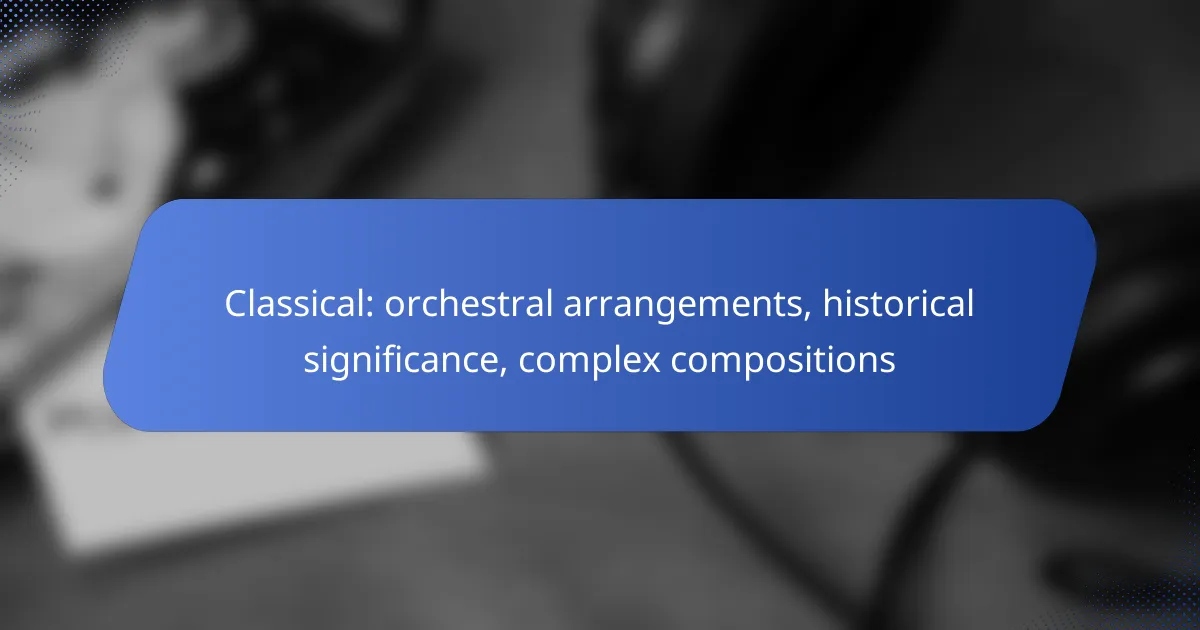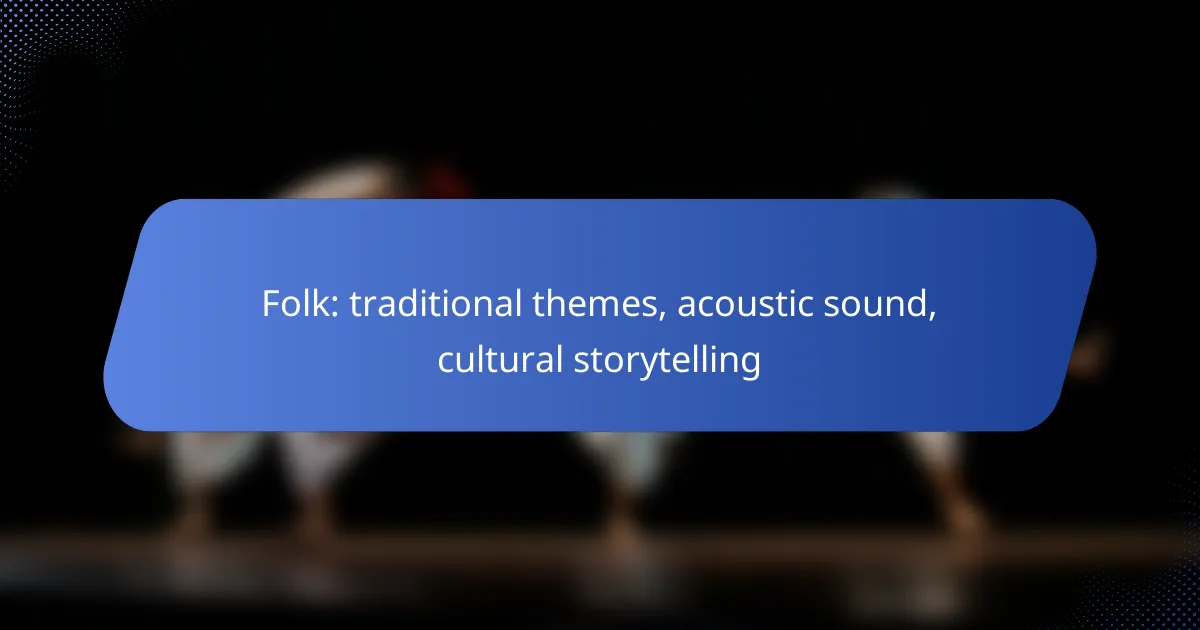The indie music scene is characterized by its diverse sounds and a do-it-yourself ethos that empowers artists to express their creativity freely. This environment encourages experimentation across genres, allowing musicians to connect with audiences on their own terms. With grassroots initiatives and a network of independent labels, artists thrive without the constraints of major record labels, fostering a vibrant community of innovation and artistic expression.

How does the indie music scene thrive in Australia?
The indie music scene in Australia thrives through a combination of grassroots initiatives, local festivals, and a strong network of independent labels. This ecosystem fosters artistic freedom and diverse sounds, allowing artists to connect with audiences without the constraints of major labels.
Local music festivals
Local music festivals play a crucial role in promoting indie artists across Australia. Events like Splendour in the Grass and Laneway Festival showcase a mix of local and international talent, providing a platform for emerging acts to gain exposure. These festivals often emphasize diverse genres, reflecting the rich tapestry of the indie music scene.
Participating in these festivals can significantly boost an artist’s visibility. Many festivals offer opportunities for networking, collaboration, and even mentorship, which can be invaluable for independent musicians looking to grow their careers.
Independent record labels
Independent record labels are vital to the Australian indie music landscape, supporting artists who seek creative control over their work. Labels like Future Classic and Spunk Records focus on nurturing talent and promoting unique sounds, often prioritizing artistic integrity over commercial success.
Working with an independent label can provide artists with essential resources, including marketing support and distribution channels. However, artists should carefully evaluate the terms of any agreements to ensure they align with their long-term goals.
Community support networks
Community support networks are integral to the indie music scene in Australia, fostering collaboration and mutual assistance among artists. Organizations like APRA AMCOS and MusicNSW offer resources, workshops, and funding opportunities to help musicians navigate the industry.
Engaging with these networks can lead to valuable connections and support systems. Artists are encouraged to participate in local meetups, online forums, and social media groups to share experiences and collaborate on projects, enhancing their presence in the indie community.
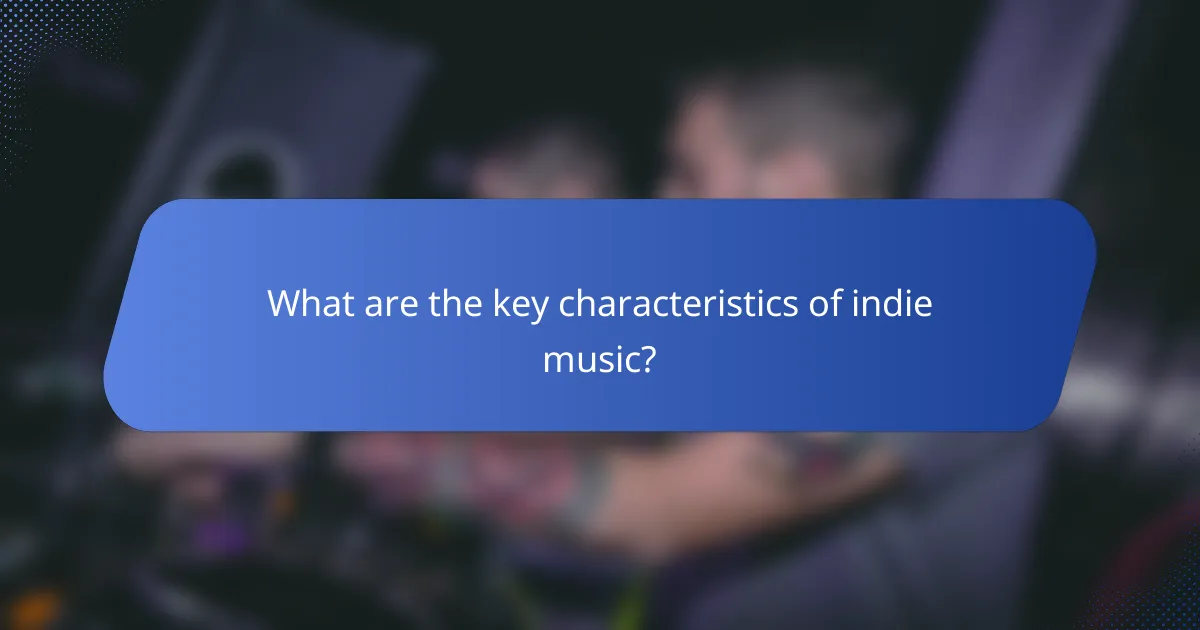
What are the key characteristics of indie music?
Indie music is defined by its diverse sounds, a do-it-yourself (DIY) approach to production, and a strong emphasis on artistic freedom. These characteristics allow artists to explore various genres and express their creativity without the constraints of major record labels.
Diverse genres and styles
Indie music encompasses a wide range of genres, including rock, pop, folk, electronic, and experimental sounds. This diversity allows artists to blend influences and create unique musical experiences that resonate with different audiences.
For instance, an indie artist might combine elements of folk with electronic beats, resulting in a fresh sound that stands apart from mainstream music. This genre fluidity encourages innovation and experimentation, appealing to listeners seeking something beyond the conventional.
DIY production techniques
The DIY ethos in indie music emphasizes self-production and independent distribution. Many artists record their music in home studios or small local studios, often using affordable equipment and software to achieve professional-quality sound.
This approach not only reduces costs but also allows for greater control over the creative process. Artists can experiment with their sound and make adjustments without the pressure of a record label’s timeline or budget constraints.
Artistic freedom and expression
Indie musicians enjoy a high degree of artistic freedom, enabling them to write and produce music that reflects their personal experiences and beliefs. This freedom often leads to more authentic and relatable content, as artists are not bound by commercial expectations.
Moreover, the indie scene fosters a supportive community where artists can collaborate and share ideas, further enhancing their creative expression. This environment encourages innovation and allows for a wide array of voices to be heard in the music landscape.
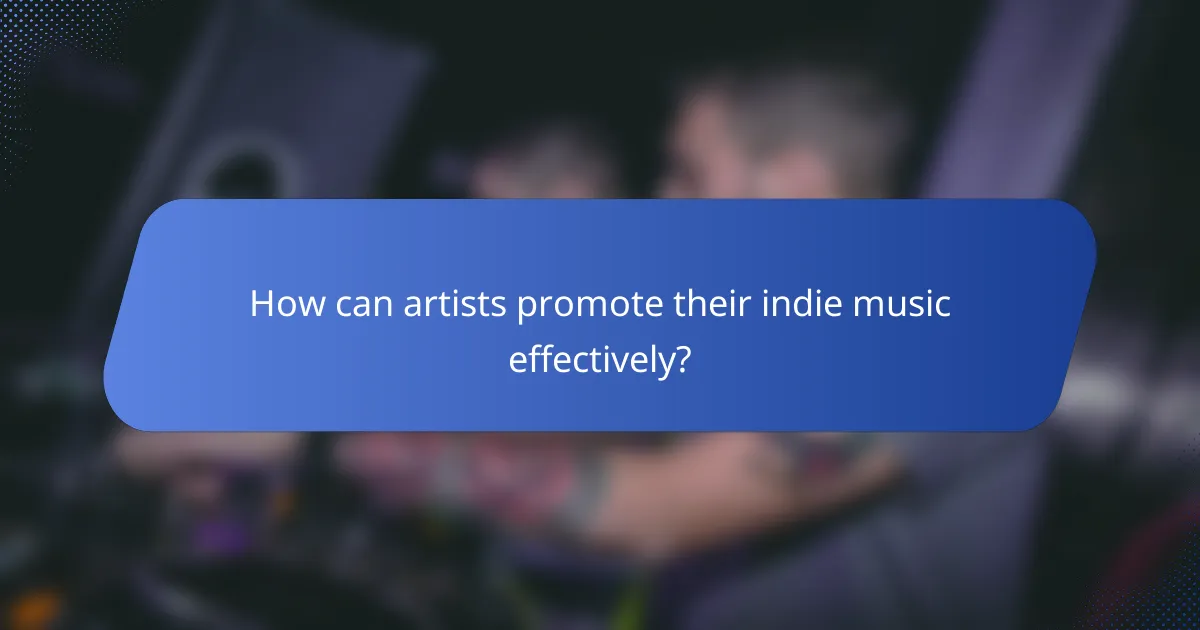
How can artists promote their indie music effectively?
Artists can promote their indie music effectively by leveraging social media, collaborating with local musicians, and utilizing streaming platforms. These strategies not only enhance visibility but also foster community engagement and listener loyalty.
Social media marketing
Social media marketing is crucial for indie artists to reach their audience directly. Platforms like Instagram, Facebook, and TikTok allow musicians to share their music, behind-the-scenes content, and personal stories, creating a deeper connection with fans.
To maximize impact, artists should post regularly, engage with followers, and use relevant hashtags. Collaborating with influencers or participating in trending challenges can also expand their reach significantly.
Collaborations with local artists
Collaborating with local artists can enhance exposure and create a supportive network within the indie music scene. Joint performances, co-writing songs, or even sharing social media promotions can introduce each artist to the other’s fan base.
These partnerships often lead to unique sounds and creative projects that resonate well with audiences. Additionally, local collaborations can help build a sense of community, which is vital for indie artists.
Utilizing streaming platforms
Streaming platforms like Spotify, Apple Music, and Bandcamp are essential for indie artists to distribute their music widely. These platforms often have tools for artists to promote their work, such as playlist placements and promotional campaigns.
Artists should consider submitting their tracks to playlists that align with their genre, as this can significantly increase their visibility. Engaging with listeners through platform features like live sessions or Q&As can also foster a loyal fan base.
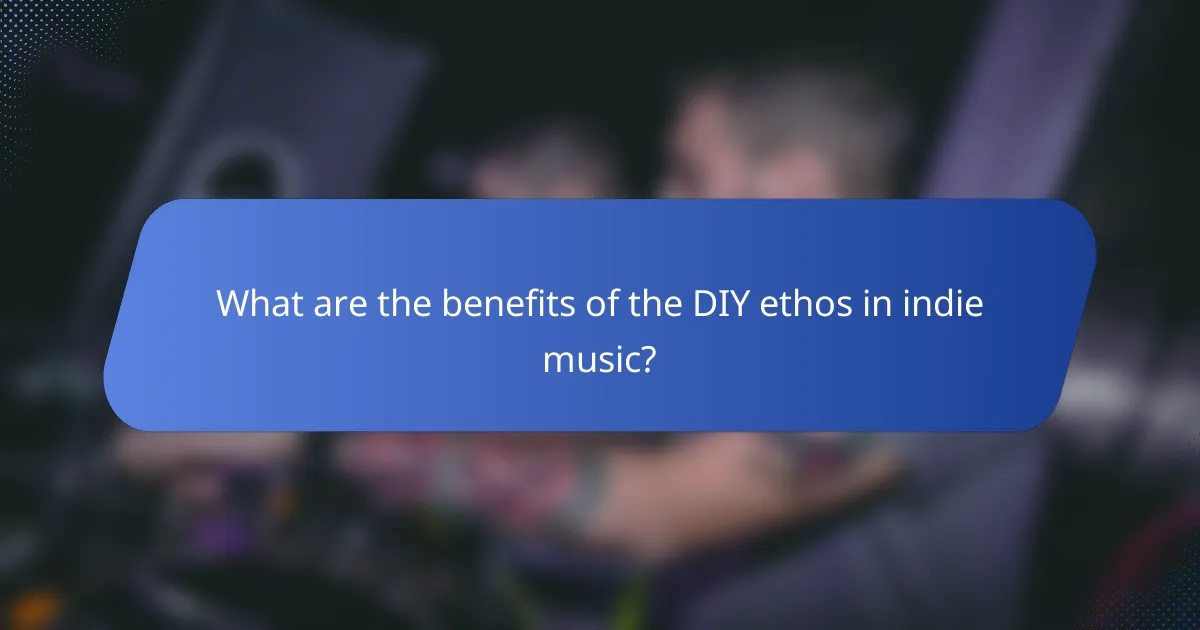
What are the benefits of the DIY ethos in indie music?
The DIY ethos in indie music offers artists significant advantages, including greater creative freedom and the ability to produce music on their own terms. This approach allows musicians to maintain artistic integrity while minimizing costs and fostering direct connections with their audience.
Creative control
Indie artists enjoy complete creative control over their music, allowing them to explore diverse sounds without commercial constraints. This freedom enables musicians to experiment with different genres, styles, and lyrical themes, resulting in a unique artistic identity.
For example, an indie band can choose to blend folk, rock, and electronic elements without worrying about fitting into a specific market. This flexibility often leads to innovative music that resonates deeply with listeners.
Cost-effective production
The DIY approach significantly reduces production costs, as artists can record and distribute their music without relying on major labels. With affordable recording technology and platforms for distribution, musicians can produce high-quality tracks for a fraction of traditional costs.
Many indie artists utilize home studios or local recording spaces, which can cost anywhere from a few hundred to a couple of thousand dollars. This financial independence allows them to allocate resources toward marketing and promotion instead.
Building a loyal fanbase
Indie musicians often cultivate a dedicated fanbase through direct engagement and authentic interactions. By connecting with fans on social media and at live shows, artists can create a sense of community that fosters loyalty.
Strategies such as offering exclusive content, personalized merchandise, or intimate performances can help strengthen these relationships. As fans feel more connected to the artist, they are more likely to support their work through purchases and word-of-mouth promotion.

What challenges do indie artists face in Australia?
Indie artists in Australia encounter several significant challenges that can hinder their growth and success. These include limited funding opportunities, fierce competition with mainstream artists, and various distribution hurdles that complicate getting their music heard.
Limited funding opportunities
Securing funding is one of the primary challenges for indie artists in Australia. Many rely on grants, crowdfunding, or personal savings, but these sources can be inconsistent and competitive. Government grants, such as those from the Australia Council for the Arts, are available but often have stringent eligibility criteria.
Artists should consider diversifying their funding strategies by exploring local sponsorships or partnerships with businesses that align with their artistic vision. Networking within the community can also lead to collaborative funding opportunities.
Competition with mainstream artists
Indie artists face intense competition from mainstream musicians who have more resources and marketing power. The saturation of the music market makes it difficult for independent acts to gain visibility. Many listeners gravitate towards well-known artists, making it crucial for indie musicians to carve out a unique niche.
To stand out, indie artists should focus on building a strong personal brand and engaging directly with their audience through social media and live performances. Developing a distinctive sound and aesthetic can also help attract a dedicated fan base.
Distribution hurdles
Distributing music effectively is another significant hurdle for indie artists in Australia. While digital platforms like Spotify and Apple Music provide access to a global audience, navigating these services can be complex. Artists must understand the intricacies of digital distribution and the importance of metadata to ensure their music is easily discoverable.
Utilizing independent distributors can help simplify the process, but artists should be aware of the fees involved. Additionally, promoting music through local radio stations and community events can enhance visibility and reach audiences that may not be active on streaming platforms.

How does artistic freedom impact indie music?
Artistic freedom significantly enhances indie music by allowing artists to explore diverse sounds and express their unique visions without commercial constraints. This freedom fosters creativity, enabling musicians to experiment with different genres, themes, and production techniques.
Encourages innovation
Artistic freedom in indie music leads to innovative sounds and styles that challenge mainstream conventions. Independent artists often blend genres, creating fresh musical experiences that resonate with niche audiences. For example, a folk artist might incorporate electronic elements, producing a hybrid sound that stands out.
This innovation is driven by the lack of pressure from record labels to conform to popular trends. Artists can take risks, leading to the emergence of new subgenres and unique collaborations that push the boundaries of traditional music.
Promotes unique storytelling
Indie music thrives on personal narratives and authentic storytelling, which are often overlooked in commercial music. Artists have the freedom to write lyrics that reflect their individual experiences, cultural backgrounds, and social issues, creating a deeper connection with listeners. This authenticity often resonates more with audiences seeking relatable content.
For instance, an indie singer-songwriter might share their journey through mental health struggles or cultural identity, offering listeners a glimpse into their world. Such storytelling not only enriches the music but also fosters a community of fans who appreciate the shared experiences and emotions conveyed through the songs.
